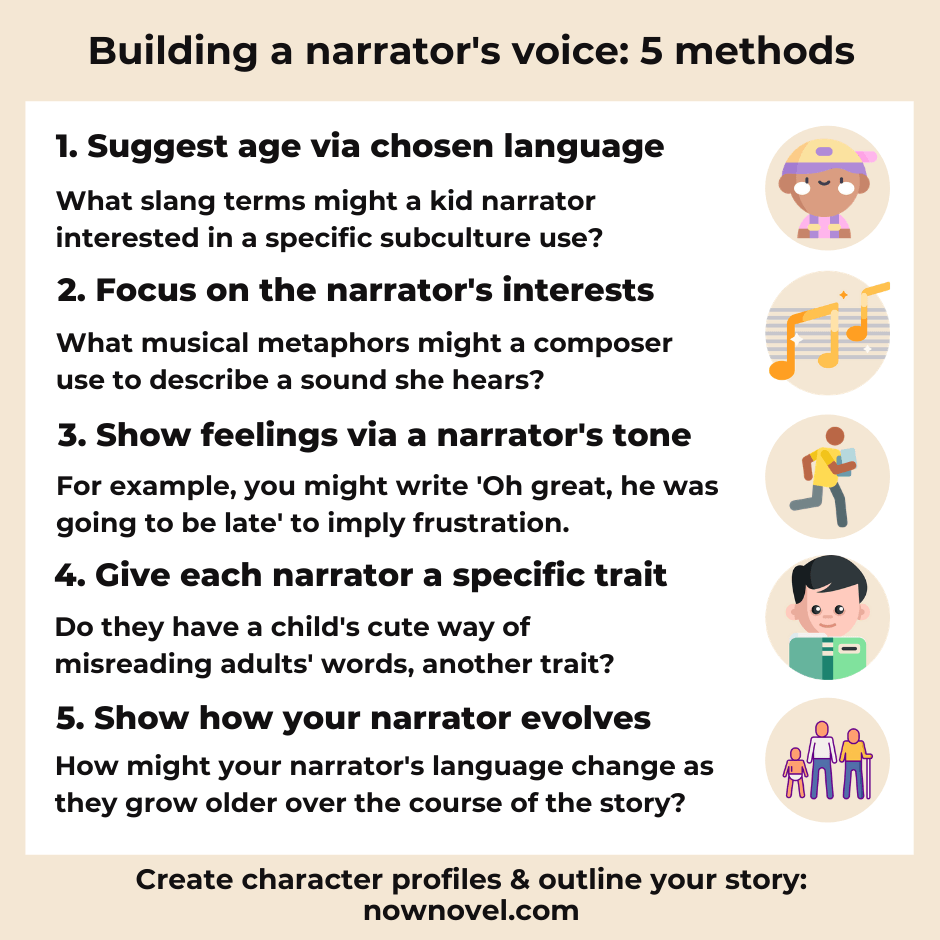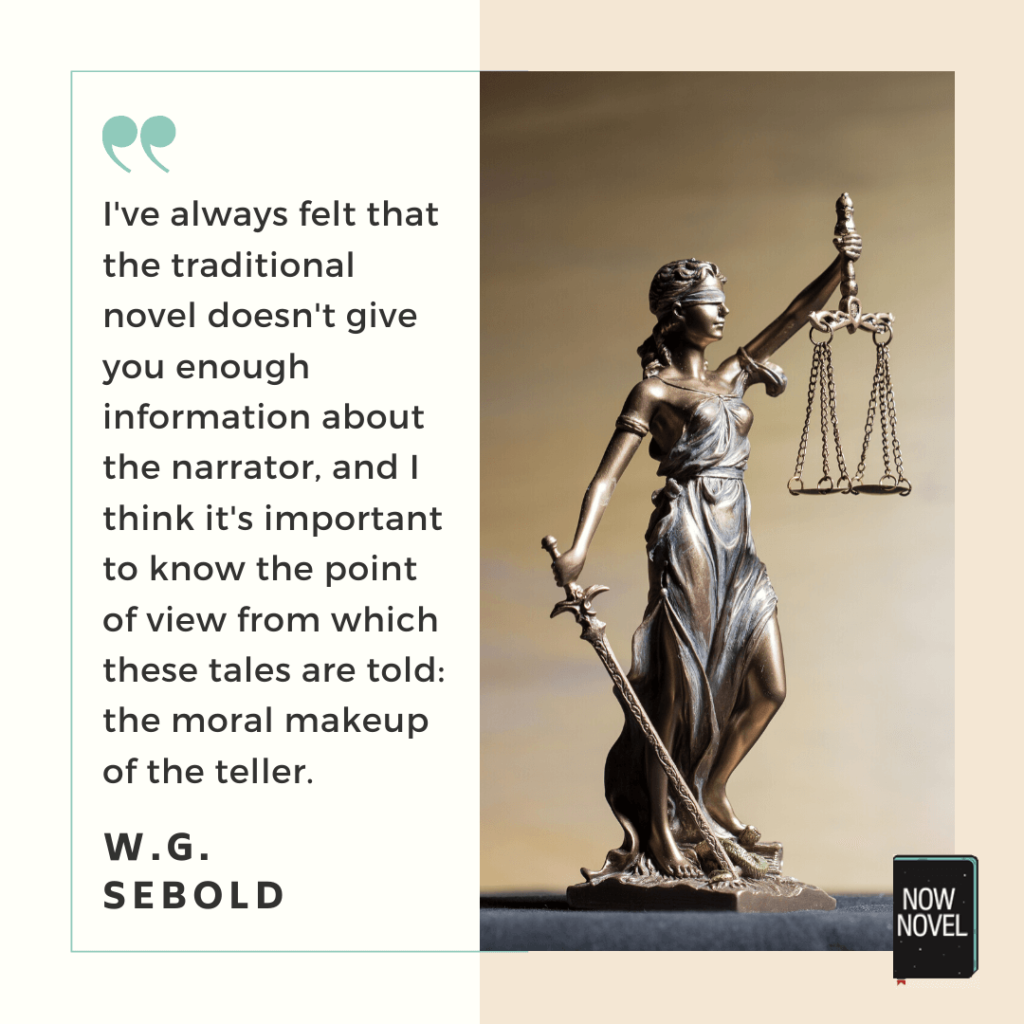Building a memorable narrator’s voice is challenging. Try these 5 methods to fill your narrator with personality:
1. Suggest age via chosen language
When the narrator is not involved in the story, is more of a passive observer, it’s fine not to give your narrator their own distinct persona.
However if you’re writing a narrator who is involved, such as a first-person narrator (the narrator who says ‘I’), the narrator's voice is important. It helps us to understand the narrator’s point of view better.
An ageing narrator might recall memories often, beginning paragraphs with ‘I remember when…’ or ‘When I was in my 20s…’ A young narrator might use slang common to their age group, calling something they like ‘sick’, ‘dank’ or another slang word.
Of course, your narrator might use language not expected of their age group too. What will the reader make of a grandma who calls her grandson’s haircut ‘sick? Or a young narrator who uses big words an adult might?
2. Focus narration on the narrator’s interests
In David Mitchell’s Cloud Atlas, the narrator of one segment of the novel, a composer, describes setting using comparisons to orchestral instruments.
Make what interests your narrator clear from the subjects they focus on. This shows indirectly who they are.
To put this another way, a narrator doesn’t have to say ‘I am a composer’, necessarily. She could say, ‘The wind in the leaves is a busy percussion solo . Every now and then there’s a low whistling of indefinite pitch, like a flautist using the wrong emboucher.’

3. Use the tone of a character’s thoughts
It’s not only in first-person narration that you can give your narrator's voice personality.
When writing third-person limited narration (where the story is following a specific character’s point of view but the narration uses ‘he’, ‘she’ or ‘they’), you can still create personality in narration.
You can do so by making the tone of narration overlap with the character’s emotions.
Consider this example:
‘Oh great, it was casual Friday again. This meant Jake would probably be wearing a gimmick hat and ramping up on the crude remarks whenever he passed Cara in the office corridor.’
Here the narration is in third person, yet it’s clear from the tone of ‘Oh great’ and the implied expectation that we're reading Cara’s frustrated perspective in the situation.
4. Give each narrator a specific trait
Barbara Kingsolver’s The Poisonwood Bible tells the story of the Prices, an American family that moves to the Congo for missionary work.
Kingsolver gives each of the Price daughters distinctive personas in the chapters they narrate.
One way Kingsolver achieves this effect is by giving each narrator distinct qualities.
The youngest daughter, Ruth May, for example, narrates her chapters in a voice that is full of wonder, curiosity and a child’s innocence.
For example, being too young to understand malnutrition, Ruth May wonders:
If somebody was hungry, why would they have a big fat belly? I don’t know.
Barbara Kingsolver, The Poisonwood Bible (1998), p. 58
Ruth May’s older sister, Adah Price, is highly intelligent and crippled. In her chapters, she often plays with words, making up anagrams or writing backwards. For example:
Walk to learn. I and Path. Long one is Congo.
Kingsolver, p. 158.
Congo is one long path and I learn to walk.
That is the name of my story, forward and backward.
Comparing the two characters, the reader has the impression of two distinct people. From each narrator's voice alone, we can tell they are at different stages of development and have different outlooks and emotions.

5. Show how your narrator evolves
If your narrator undergoes substantial change in your story, consider having their voice evolve.
An extreme example is in James Joyce’s Portrait of the Artist of the Young Man. In this coming-of-age novel or bildungsroman, Joyce begins with a narrative style reflecting the protagonist being a child in the first chapter:
Once upon a time and a very good time it was there was a moocow coming down along the road and this moocow that was coming down along the road met a nicens little boy named baby tuckoo.
James Joyce, Portrait of the Artist as a Young Man (1916), full text available here.
Even though it is not Stephen, the protagonist, narrating, the narration mimics a child’s language in referring to a cow as a ‘moocow’.
As the story evolves, and Stephen grows older, the complexity of language in the narration increases.
You might prefer to keep the narrative voice older, even if your protagonist is young to begin.
Think about how else the narrative voice might evolve. If, for example, your narrator begins the story young and full of optimism and ends the story older but a little jaded, how could the narration reflect this change? Do they use more negative words, or express doubts more frequently in later chapters? Do they focus on memories more than current events?
Paying attention to details of narration in this way will help you breathe character into your narrators and create memorable voices.
Need feedback on your finished draft? Request a no-obligation quote for a manuscript evaluation now.









I prefer writing with more than one POV, distinguishing each one by scene. Can these suggestions work with this?
Glynis Jolly - Almost 5 years ago
Hi Glynis, thank you for asking! I would say most definitely, some of these things will help individuate each narrator more (for example, a colder, more calculating character might use less emotive language than an emotional one). Good luck with your multiple POVs!
Jordan At Now Novel - Almost 5 years ago